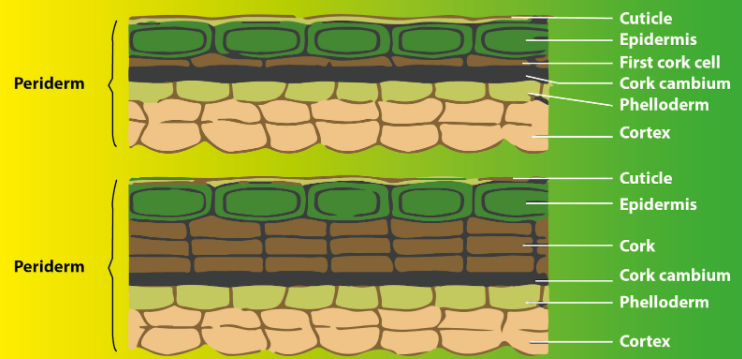
Periderm includes:
(a) Cork cambium (phellogen), cork (phellem), and secondary cortex (Phelloderm)
(b) Cork cambium and Cork
(c) Cork
(d) Cork and secondary phloem.
Answer
486.9k+ views
Hint: The periderm is made up of three protective layer cells that grow after the rupture of the epidermis and outer cortical layers of the primary plant body.
Complete answer:
As a result of the continued activity of vascular cambium, the girth of the stem goes on increasing. The continuous increase in the girth results in the rupture of the outermost layer i.e. epidermis and outer cortical layers (layers of cortex). Due to the ruptures, they need to be replaced to protect the stem. New protective cell layers are provided by another lateral meristem i.e. cork cambium. It is also called phellogen. It develops during the ongoing process of secondary growth. This meristematic tissue develops usually in the cortex region.
The outer cells of phellogen differentiate into the cork or phellem while the inner cells differentiate into the secondary cortex or phelloderm.
Cork or Phellem cells are compactly arranged and have thin cellulosic walls in the beginning. As they mature, there is a gradual loss of living matter and their cell walls become thick.
Phelloderm or the secondary cortex is a thin- walled parenchymatous cell. These are living cells that possess cellulosic cell walls.
Phellogen, Phellem, Phelloderm are collectively known as periderm. These all are the protective layers that grow due to the rupture of the epidermis and the outer layer of the cortex of the primary plant. Hence, secondary growth in the cortex with the help of cork cambium is the result of secondary growth by the vascular cambium.

So, the answer is, ‘Cork cambium (phellogen), cork (phellem), and secondary cortex (Phelloderm)’..
Note: - Due to the origin outside the stele, the cork cambium is also called as extra- stellar cambium (stele comprises all the tissues on the inner side of the epidermis, i.e., pericycle, vascular bundles, and pith. - Phellogen is a couple of layers thick and has two layers of meristematic cells. - Cork becomes thick due to the deposition of a fatty substance caller suberin. The suberin deposition in the cell wall makes the cork impervious to water.
Complete answer:
As a result of the continued activity of vascular cambium, the girth of the stem goes on increasing. The continuous increase in the girth results in the rupture of the outermost layer i.e. epidermis and outer cortical layers (layers of cortex). Due to the ruptures, they need to be replaced to protect the stem. New protective cell layers are provided by another lateral meristem i.e. cork cambium. It is also called phellogen. It develops during the ongoing process of secondary growth. This meristematic tissue develops usually in the cortex region.
The outer cells of phellogen differentiate into the cork or phellem while the inner cells differentiate into the secondary cortex or phelloderm.
Cork or Phellem cells are compactly arranged and have thin cellulosic walls in the beginning. As they mature, there is a gradual loss of living matter and their cell walls become thick.
Phelloderm or the secondary cortex is a thin- walled parenchymatous cell. These are living cells that possess cellulosic cell walls.
Phellogen, Phellem, Phelloderm are collectively known as periderm. These all are the protective layers that grow due to the rupture of the epidermis and the outer layer of the cortex of the primary plant. Hence, secondary growth in the cortex with the help of cork cambium is the result of secondary growth by the vascular cambium.

So, the answer is, ‘Cork cambium (phellogen), cork (phellem), and secondary cortex (Phelloderm)’..
Note: - Due to the origin outside the stele, the cork cambium is also called as extra- stellar cambium (stele comprises all the tissues on the inner side of the epidermis, i.e., pericycle, vascular bundles, and pith. - Phellogen is a couple of layers thick and has two layers of meristematic cells. - Cork becomes thick due to the deposition of a fatty substance caller suberin. The suberin deposition in the cell wall makes the cork impervious to water.
Recently Updated Pages
How do you factor x2 + x 20 0 class 9 maths CBSE

How do you solve y6x and 2x+3y20 using substitutio class 9 maths CBSE

Chipko movement originated in Gopeshwar in A 1953 B class 9 biology CBSE

The adjacent sides in the parallelogram are supplementary class 9 maths CBSE

The compound used in plastic industry is A Vinyl acetate class 9 chemistry CBSE

How do you solve for y in 2left y dfrac12 right 4left class 9 maths CBSE

Trending doubts
According to Bernoullis equation the expression which class 11 physics CBSE

Draw a diagram of nephron and explain its structur class 11 biology CBSE

Differentiate between calcination and roasting class 11 chemistry CBSE

A solution of a substance X is used for white washing class 11 chemistry CBSE

What is spore formation class 11 biology CBSE

10 examples of friction in our daily life




